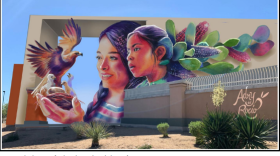I was in no rush to see Oil, the exhibit of large-format photographs by Canadian artist Edward Burtynsky, which opened back in September at UNLV’s Barrick Museum. For one thing, it’s up until January 14 — still a lotta time on the clock. But for another, knowing Burtynsky’s subject (the life cycle of oil, from drilling to disposal) I had a pretty good idea of what I’d see. Petroleum gothic: vistas of industrial grime and the desolate machinery of extraction; bafflingly dense pipescapes only a cyborg could love, each limned in harsh chemical lights; highways choked with cars whose drivers remain oblivious to the massively destructive process that makes it all go. Blights on the land. Oodles of black goop. All presented with a documentary matter-of-factness that not so subtly implicates the viewer: Do you understand what we’re doing here?
And, in a sense, that’s more or less what I saw when I finally stopped by recently. It’s a big, muscular exhibit, all right, definitely geeked up with highways, pipes, machinery and enough oily muck to style Andrew Dice Clay’s hair. Burtynsky, it must be said, is a terrifically skilled photographer. A swatch of California desert punctured by dozens of oil wells is, objectively speaking, damned ugly; and yet, shot from above and spreading away to the far edge of the picture plane, Burtynsky’s oversize diptych delivers a weird, morally complex but undeniable aesthetic satisfaction. (Maybe it’s because aerial shots subtly flatter you with a god’s perspective.) Similarly, in his shot of a sloppy oil field in Azerbaijan, the image’s appealing symmetries — towers and wires reflected in a pool of petroleum runoff — counterpoint its grotesque content. Burtynsky has an eye for these resonant patterns: His photos of abandoned military planes lined up in a field near Tucson are marvels of composition. Look at it for a few minutes and his exquisitely detailed, two-part photo of a mountain of used tires assumes the mesmeric quality of an abstract painting.
What I didn’t expect was the show’s cumulative wallop. If I was blasé about Oil before — *Scott arches one eyebrow in an I’ve-seen-it-all look* — viewing it in person dispelled my nonchalance. Burtynsky’s artistic strengths, from his compositional clarity to his willingness to gaze unflinchingly into his subject’s grimmest corners, are neatly augmented by the size of the images. They’re big, and that’s no small thing. Size thickens their presence in the Barrick’s quiet gallery, the smothering scale of image-to-viewer bringing home — embodying, really — the overwhelming, implacable, terrifyingly damaging, globe-strangling vastness of the petroleum process. And it’s not all about oil-slicked machinery in Azerbaijan: When Burtynsky illustrates petroleum’s end-users by shooting affluent Las Vegas suburbs from above, you don’t need a snarky caption to grasp those blocks of repetitive sameness as a despairing symbol of our clueless, heedless, ultimately unsustainable consumption.
Vistas he’s obviously great at, but Burtynsky can bring it down to the individual human level, too. For me, the most affecting image in the show is “Shipbreaking #23,” which foregrounds a young Bangladeshi man against a massive, pipe-bristling structure — another canny use of scale — in a statement about just how intractable, ultimately unsolvable the petro-reality is. Whether you find Burtynsky’s visions demoralizing or a call to action, or, like me, something in between, you really should hit the Barrick before January 14, though Oil will make you regret using your car to get there.
Edward Burtynsky, Shipbreaking #23, Chittagong, Bangladesh, 2000. Chromogenic color print. Collection of the Nevada Museum of Art, The Altered Landscape, Carol Franc Buck Collection. Photograph © Edward Burtynsky, courtesy Metivier Gallery Toronto / Von Lintel Gallery, Los Angeles.
Edward Burtynsky, Recycling #2, Chittagong, Bangladesh, 2001. Chromogenic color print. Collection of the Nevada Museum of Art, The Altered Landscape, Carol Franc Buck Collection. Photograph © Edward Burtynsky, courtesy Metivier Gallery Toronto / Von Lintel Gallery, Los Angeles.
Edward Burtynsky, Oil Refineries #22, St. John, New Brunswick, Canada, 1999. Chromogenic color print. Collection of the Nevada Museum of Art, The Altered Landscape, Carol Franc Buck Collection. Photograph © Edward Burtynsky, courtesy Metivier Gallery Toronto / Von Lintel Gallery, Los Angeles.










